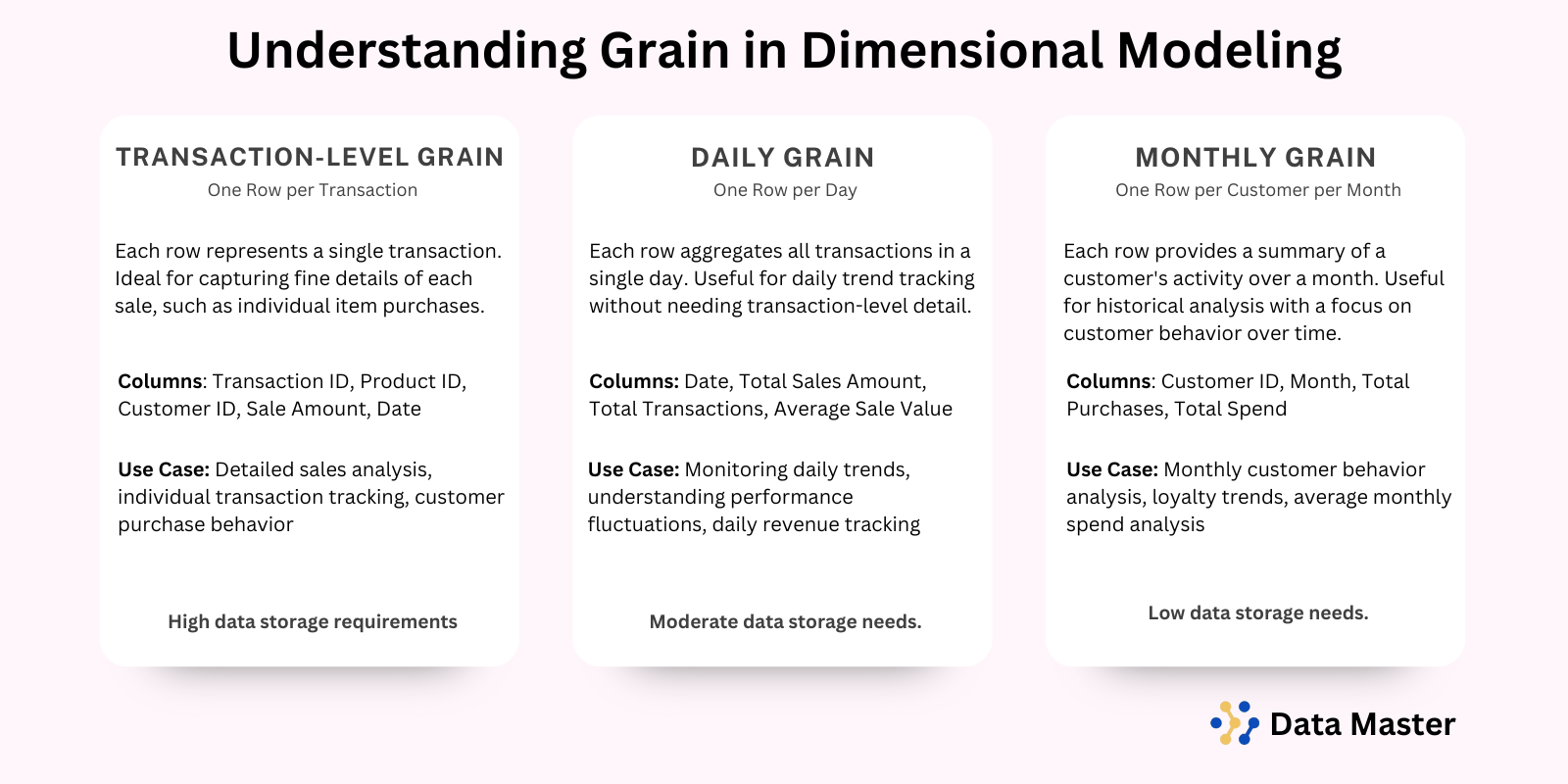In dimensional modeling, declaring the grain is a critical step that establishes the level of detail, or granularity, for each row in a fact table. Declaring the grain is essential for designing a clear, consistent data model that accurately reflects the business processes it’s intended to measure. By defining the grain at the outset, you prevent data redundancy, optimize query performance, and ensure users can interpret and trust the data.
In this post, we’ll explore why declaring the grain is so important, the common challenges associated with granularity, and best practices for defining it in your data model.
What is Grain in Dimensional Modeling?
In dimensional modeling, the grain specifies the level of detail represented by each row in a fact table. Grain defines what each row represents in business terms—whether it’s an individual transaction, a daily sales summary, or a monthly snapshot. For instance, a fact table with a grain of “one row per transaction” will have a separate row for every sale, while a grain of “one row per day” would aggregate all sales data for each day.
For more foundational knowledge on organizing data effectively, check out our introduction to dimensional modeling.
Why Declaring the Grain is Essential
Declaring the grain upfront ensures that your data model aligns with business needs and accurately reflects the intended analytical scope. Here’s why it’s essential:
- Defines the Structure of Fact Tables
Declaring the grain determines the structure of fact tables, which store quantitative metrics. For example, in a sales data model, choosing between a daily grain and a transaction-level grain will impact the table’s size, storage requirements, and overall performance. Learn more about organizing quantitative data in fact tables. - Ensures Consistency in Analysis
Consistency in granularity helps users interpret data correctly. When the grain is clearly defined, users can be confident that each row represents a single, unambiguous unit of analysis, avoiding double-counting or misinterpretation of aggregated values. - Improves Query Performance
A clearly defined grain simplifies queries by reducing the need for complex aggregations. Fact tables with a uniform grain provide predictable results, enabling faster retrieval times, which is especially useful in business intelligence (BI) reporting. - Avoids Data Redundancy
By specifying the appropriate level of detail, you prevent redundant data storage and optimize your database for both speed and storage efficiency. For example, a grain of “one row per customer per month” eliminates repetitive transaction data, saving space.
Common Challenges with Grain in Dimensional Modeling
Declaring the grain isn’t always straightforward. Here are some common challenges data modelers encounter:
- Mixed Granularities
Mixing different levels of granularity within a single fact table (e.g., including both daily and monthly data in the same table) can cause data inconsistencies and lead to inaccurate reporting. Instead, consider separate fact tables for each level of granularity, or use aggregation tables to store pre-aggregated values. - Changing Business Requirements
As business needs evolve, the required level of granularity may change. For instance, an initial model might require monthly summaries, but later expand to transaction-level detail. Declaring the grain upfront, however, provides a stable foundation to manage changes effectively. - Handling Slowly Changing Dimensions (SCDs)
Fact tables with different granularities can become challenging when dimension data changes over time, as seen in Slowly Changing Dimensions (SCDs). To preserve historical accuracy, ensure each fact table’s grain aligns with how dimension tables track historical data. Learn more about managing changing dimension data in our post on SCD best practices.
Best Practices for Declaring the Grain
To avoid challenges and ensure your data model supports reliable analysis, consider these best practices for declaring the grain:
- Define the Grain Early
Establish the grain before designing your fact tables. In the initial stages of dimensional modeling, determine if your fact tables will record individual transactions, daily totals, or other levels of aggregation. - Align with Business Processes
The grain should correspond to the business processes you’re measuring. For example, if your process is sales transactions, choose a grain that reflects transaction-level detail. For more on identifying and measuring business processes, see our guide to fact tables. - Document the Grain in Metadata
Clearly document the grain in your data model’s metadata, including a description of what each row represents. This documentation ensures that end-users, data analysts, and engineers understand the structure and purpose of each fact table. - Create Separate Fact Tables for Different Granularities
If you need multiple granularities, create separate fact tables to keep each grain consistent. For example, maintain one fact table for daily summaries and another for transaction-level data, ensuring each is independent and easily interpretable.
Example of Declaring the Grain
Let’s consider an example in the context of e-commerce sales:
Business Process: Sales transactions
Grain Declaration: “One row per transaction”
Fact Table Design: The fact table will include one row for each individual sale, with metrics such as Transaction Amount, Quantity Sold, and Discount Applied. Dimension keys link to tables like Customer, Product, and Date, allowing users to analyze metrics across various dimensions.
For comparison, if the business needed to analyze daily sales performance, the grain could be adjusted to “one row per day,” aggregating all sales transactions for each day into a daily total.
Conclusion
Declaring the grain in dimensional modeling is essential for creating a structured, efficient, and easily interpretable data warehouse. It ensures consistency, improves performance, and aligns data with business processes. By defining the grain early and documenting it thoroughly, you build a strong foundation for analysis, enabling your organization to extract reliable insights from its data warehouse.
For more insights on designing your data warehouse, explore our posts on dimensional modeling basics and Star vs. Snowflake schema design.
Related Blogs
Discover more from Data Master
Subscribe to get the latest posts sent to your email.



